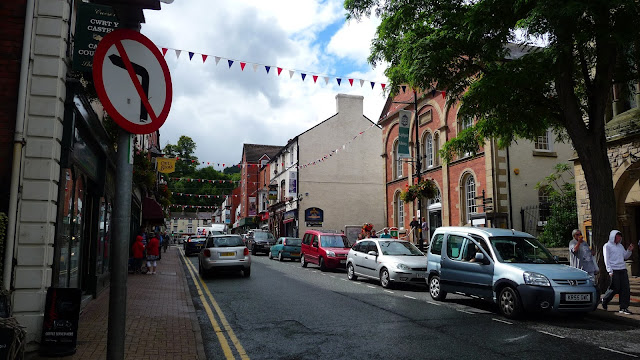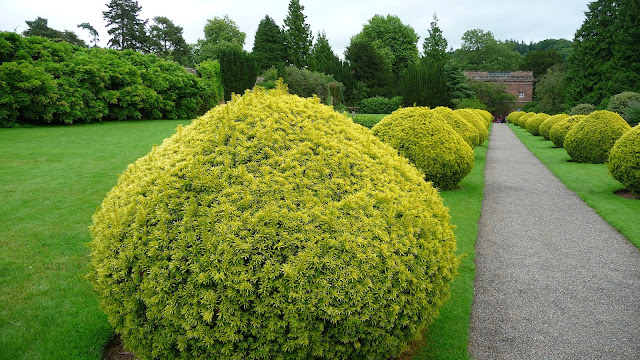I had to look up the name for this part of the country--the part of England hugging the border of Wales. It's the West Midlands, guys. There's an East Midlands, too, you might guess, but it's the west ones we went to after leaving North Wales.
Tony and Sue’s good friends, Rob and Karen, who visited us in London
earlier in the summer, invited all of us up to their cottage in the countryside
near the charming medieval city of Ludlow. Since it was more or less on the way
home from Wales, we decided to spend a couple of nights there before heading
back to London. Rob and Karen are a lovely couple (I have met only lovely
couples, really--England is apparently full of them) who found each other again
later in life after raising separate families. They’re now building their dream
life in a cozy sixteenth-century cottage, tucked into the hills of
Herefordshire. “Charming” is not really an adequate word to describe their
home. My photos won’t do it justice, but I tried my best:
We made another pitstop in Shrewsbury, just across the border (my
brother tells me to use caution in applying that word here) into England.
Shrewsbury has the half-timbered medieval buildings I’ve come to expect in
these little towns, but it’s main claim to fame is as the birthplace of the one
and only Charles Darwin. We were only really there to grab lunch and take a
quick walk through the city, though, so I didn’t see any Darwin-related things.
 |
| Shrewsbury. |
We only really had one and a half days with Rob and Karen. One morning
was spent going to Barrington Hall, to kindly satisfy my desire to visit a
stately manor house. It did not disappoint.
 |
| Barrington Hall. Not much to look at from the outside. |
 |
| Inside, though, it was all very Downton Abbey-esque. Downtown Abbey, of course, is filmed in a real state house outside of London, but you have to book tickets months ahead of time due to the popularity of the show. |
 |
| A barn AND a bookstore! Amazing. |
 |
| The grounds. |
Karen stayed behind to do some work, so I borrowed her National Trust
membership card to get into the house for free. It worked, despite the fact
that I was wearing my Vancouver Olympic sweater with “CANADA” emblazoned on the
front and despite, well, my decidedly North American accent, which I did my
best not to reveal by staying quiet. This trip has brought out the worse in me
in terms of getting questionably legal deals on admission.
We picked Karen up after a snack of scones (sans cream) in Barrington
Hall’s tea room (housed in the former servant’s hall in the basement--very
Downton Abbey, again), and drove back across into Wales to visit the town of
Hay-on-Wye. Hay-on-Wye is famous for being a centre for second-hand books. I’m
not really sure how it came to be this way, because it’s a teensy tiny little
town in the middle of quiet, bucolic countryside, but certainly
there were a great deal of second-hand bookshops that we had fun perusing.
 |
| Hay-on-Wye. |
 |
| The Wye. |
 |
| Another heron for Angie. |
On our last day at Rob and Karen’s, Tony, Sue and I went for a long
walk while Rob and Karen dealt with contractors who came to advise them on
renovations they want to do to their centuries-old cottage. We happily occupied
ourselves by marching through fields of sheep and cows in a light
drizzle--something the Scots call “Scotch mist.” Our walk took us through the tiny,
itty-bitty village of Elton, with its own stately home, Elton Hall. Unlike
Barrington Hall, though, Elton Hall is still a private residence, but public
footpaths lead through the estate into the wooded hills beyond. The thing is,
we couldn’t seem to find the not-very-well-marked path, so we ended up doing
some accidental trespassing.
Really, though, this sign should have tipped us off:
That path took us up to a gamekeeper’s cabin and a giant fenced off
area within the woods where they were raising poor little pheasants or grouse
or something. Later on, wandering back from our misadventures, we came across
the lady of the house, an aristocratic woman really wearing tweed and walking
about seven dogs at once. She was kind, though, and we asked her about that
sign, which she said was one of her husband’s jokes. It was a real sign, in
that it had once been meant in full earnestness, but it had originated from
another estate.
 |
| The back of Elton Hall. |
 |
| The chapel next to Elton Hall. |
 |
| This is the "town" of Elton. Note the mailbox has the initials "VR," for Victoria. That's a pretty old mailbox, people. |
We spent our final afternoon quickly exploring the hilly town of
Ludlow, which may just win the prize for the prettiest town I’ve been in so
far--a close tie with Conwy in North Wales.
CREAM TEA COUNT: 11






















































No comments:
Post a Comment